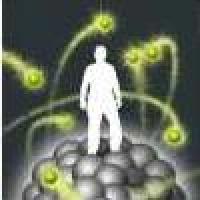
Spooky action found in gases
Researchers in Germany have created a rare example of a weird phenomenon predicted by quantum mechanics: quantum entanglement, or as Einstein called it, "spooky action at a distance". The idea, loosely speaking, is that particles which have once interacted physically remain linked to each other even when they're moved apart and seem to affect each other instantaneously.

Einstein himself did not believe that such an effect could exist. To him, the fact that quantum mechanics predicted such odd behaviour merely showed that, as a mathematical description of the world, it wasn't quite complete. This new experiment isn't the first to prove Einstein wrong, but it's interesting to physicists because it required novel techniques.
Particles can be entangled in different ways. For example, a photon (a particle of light) may decay into two new photons in a special kind of crystal (see the Plus article Cracking codes). Photons possess an observable quantity called spin, a kind of internal angular momentum, which when measured in some direction will either be up or down (see the Plus article In a spin). According to quantum mechanics, if one measures the spin of one photon to be up in some direction, at that very instant the spin of the other photon will be down in the same direction, no matter how far the photons are apart — that's because the two particles have been entangled.
This isn't particularly strange if you think that the spin values were set in stone when the photons were created. But quantum mechanics predicts another weird thing: an individual photon does not have a well-defined value for its spin in a particular direction until you make a measurement. The photon exists in a strange superposition of the two possibilities and only when you measure it does it "decide" at random which answer it is going to give, "up" or "down". It's a concept that's hard to grasp — Einstein certainly refused to accept it — but it can be described precisely using mathematical probabilities.
And this is what turns entanglement into a spooky action at a distance. If you measure the spin of one of the entangled particles and get your random answer, this instantaneously determines the answer of the other particle, even if they are light years apart.
In their experiment the German team, led by Markus Oberthaler at the Kirchhoff Institute for Physics, have created a special form of quantum entanglement, called mode entanglement, which rather than involving two particles involves two gases, each containing on average 40 particles. In each gas they measured a property called quadrature and found that the values of quadrature in the gases correlate to a greater extent than classical (that is non-quantum) physics can explain. What is novel about their work is the method they used for accessing these quadratures. "It took so long to get access to [the quadratures] since they are 'encoded' in noise — which is tricky to observe since there are usually many annoying noise sources which are just classical," says Oberthaler. "Thus the experimental challenge is to get the environment under control such that technical noise is not hiding the interesting 'quantum noise'." The result has been published in Nature.